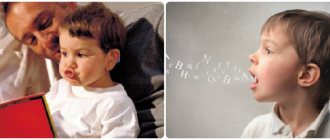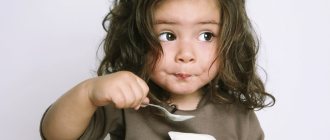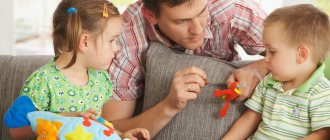The most active period of speech formation is the age of 3-4 years.
At this time, the child takes a huge step forward compared to his previous speech skills. He already knows how to generalize similar objects and phenomena, his speech becomes richer and understandable to others. Speech development is directly related to the mental and intellectual status of the child, so it is important that he does not lag behind age norms. Undoubtedly, each baby develops at its own pace, however, deviations are acceptable only for a couple of months. In order to make sure that speech formation occurs at the right pace, it is necessary to closely monitor the child. Experts recommend starting from the age of one year to be examined by a speech therapist-defectologist. A problem identified in a timely manner is much easier to correct.
How should your child speak?
Speech therapists identify several characteristic features of the speech state corresponding to this age:
- A rather impressive vocabulary is already being formed - from 1500 to 2000 words in the active vocabulary. The passive vocabulary, accordingly, becomes even more extensive.
- Phrases become more complex, and the child is able to construct common sentences using new parts of speech. Previously, sentences consisted only of nouns and verbs, but now adverbs, adjectives, etc. are actively used.
- Pronunciation improves significantly, although some mispronounced sounds still occur. At the same time, it is noticeable that children know well how words should sound correctly and note other people’s mistakes.
- Prepositions and conjunctions are used in speech. Verbs are used in the correct tense and form.
- The child is actively engaged in word creation, forming new forms and words.
- It does not cause difficulties in describing the characteristics of objects and actions; the child is able to combine objects into groups according to similar characteristics.
- The ability to construct a coherent story is developed. The child can talk about the events of the day, retell a fairy tale or cartoon.
However, not everything is still going well. Some violations of sound pronunciation, incorrect agreements in sentences and speech errors are common. In order to help the child, parents must be attentive, pay attention to problems encountered and try to correct them.
How can parents help?
If everything is fine with the baby, you should not think that his speech will form on its own. It has already been said here what problems are typical for children 3–4 years old. These are what you need to work on, constantly playing exciting games with children that develop speech.
So, what exactly needs the attention of adults now?
- Logical thinking, attention, memory. This will allow the child to remember more of what he read or saw, reason about it, draw conclusions, and express his thoughts consistently.
- The ability to use words in speech syntactically correctly (use gender, number, case, person to use the correct endings).
- Expanding vocabulary. This is one of the most important aspects of speech development, allowing the baby to speak fully, clearly and widely.
- Mastering different forms of speech (dialogue, monologue, description).
- Working on improving articulation. This is important so that the baby can quickly master sounds that are difficult for him (you can read more about articulatory gymnastics here).
- Expressiveness, tempo, intonation. The child needs to be taught to speak with the right strength of voice, according to the situation, to color speech emotionally, not to jabber or drag out words.
- Phonemic hearing. It is important for a child to learn to correctly perceive each sound in a word, to hear the number of syllables and their order.
- Fine motor skills. It will help the child improve pronunciation and activate the brain centers responsible for speech development (examples of games for the development of motor skills can be found here - “Hand motor skills for speech development”).
Pay special attention to those problems that your child has specifically (perhaps he cannot group objects according to common characteristics, or does not pronounce specific sounds, or has difficulty remembering text).
How to develop speech at 3-4 years old
The main process of speech development in a child occurs in everyday communication. Parents should pay attention to how the child speaks and be sure to encourage him to talk. There are several rules that should not be forgotten:
- Talk to your child correctly, watch his diction and phrase construction.
- Be sure to encourage children to tell stories, help by asking leading questions and providing emotional support.
- Do not interrupt your child by encouraging him to talk.
- Expand your child’s social circle by encouraging him to enrich his vocabulary.
- Spend time reading and looking at picture books. Discuss everything that happens on a walk, at home or in kindergarten. The more you read and communicate, the faster your child’s vocabulary develops, and the more correct the construction of speech becomes.
- Be sure to celebrate all your child’s achievements and praise him. Moral and psychological support, timely praise become a powerful incentive for development.
Possible causes of violations
Disturbances in the speech development of a preschooler may be associated with medical indicators or the child’s social environment.
Medical reasons:
- Mother's illnesses during pregnancy, smoking, alcoholism and drug addiction;
- Birth injuries and other complications;
- Head injury in the first 3 years of the baby;
- Left-handed child;
- The special structure of the articulatory apparatus;
- Heredity and genetic predisposition to speech disorders.
Social environmental factors:
- The baby hears little correctly delivered speech, adults are not interested in constant communication with him;
- Adults speak incorrectly (with mistakes, burr) or “lisp” with the child. As a result, by repeating, the baby remembers this manner of speech;
- An adult demands to pronounce the sound correctly, but at the same time does not show correct articulation. Often this leads to incorrect sound production, which subsequently has to be corrected (for example, “R” is pronounced with the throat).
Parents should talk to their children a lot
Exercises for speech development
Games with words expand vocabulary, help the child “feel” his native language, and learn how to structure his speech correctly. Such entertaining activities are great for passing the time on the road, on a walk, or just having fun at home.
Children willingly play “words” with adults. All adults know these games very well:
- Choose words starting with the selected letter.
- Ask your child to identify the location of the toy (under the table, on the table, near the table, etc.).
- Form adjectives (a silver spoon is a silver spoon, a fox's tail is a fox's tail).
- Choose rhymes for words. Having grasped the principle, children enjoy playing poetry.
- Say one phrase quietly, loudly and in a normal voice. Change the timbre and tempo of your voice.
Learn more about developmental activities for children 2-3 years old and 4-5 years old.
Characteristics of the development of a 3-4 year old child
At 3 years old, the child is open to learning his native language, he happily repeats everything after an adult and is actively engaged in word formation. By the age of 4, the passive vocabulary reaches 2,500 words, most of which are verbs and nouns.
Three-year-old children have an extensive passive vocabulary
The child’s speech also contains:
- simple adjectives (beautiful, small, big);
- possessive pronouns (my);
- generalization words (animals, vegetables).
A preschooler does not yet have much life experience and produces new words in his own way. This gives rise to curious word forms, for example: “Mom is studying, but I am a lazybones.” A three-year-old child is able to maintain a simple dialogue.
The most difficult sounds to pronounce are “R” and “L”, as well as the whistling “Sh”, “S”, “F”. Often, even after reaching four years of age, the child is not able to pronounce them.
Important! If at 3-4 years old a child does not pronounce all sounds clearly, this is not a reason to run to a speech therapist. The sounds “R”, “L”, “Sh”, “S”, “F” are usually introduced at a later age. However, if by the age of 3 the baby does not speak at all, and there were serious illnesses or injuries during pregnancy/birth/in the first year, consultation with specialists is required. Based on the results of the examinations, a psychologist, speech therapist and neurologist will tell you what speech therapy exercises for children 3-4 years old should be performed.
Development of fine motor skills
Stimulating motor skills is still very important. All activities that require careful use of hands and fingers also affect the speech center in the brain. So give your child maximum opportunities for this:
- Draw on cereals and flour, sort through beans.
- Buy or make your own lacing games. A bonus will be the complete absence of problems with lacing your boots.
- Games with plasticine, drawing, and appliqué activities are useful for motor skills and develop imagination and creativity. Come up with unusual ideas - you can paint pictures on paper with plasticine, press peas or beads into it, etc.
- Play "magic bag". Place various shaped items into an opaque bag or bag. Let the child try to guess each one by touch.
Tests to determine pathologies
To quickly respond to changes in the baby’s development, you can conduct simple tests.
- By the fourth year, children can already distinguish the simplest geometric shapes. You need to ask the child to draw a circle. Even the similarity of this figure is a good result. However, if the child does not understand what is wanted from him, or his drawing does not even remotely resemble what is required, the test has not been passed.
- If a child does not show interest in new games and does not assemble a small tower from cubes, development is slow.
- By the age of three, the toddler communicates in short phrases (those who at this age already speak in long sentences are not taken into account). The minimum milestone for speech development by 3-4 years is the simplest phrases. If the child does not pronounce them, you should go to a specialist.
Complex of articulation gymnastics for children 4-5 years old in the middle group
In what cases is it still necessary to contact a speech therapist:
- The baby does not respond to his name and does not understand simple requests.
- Shows no interest in new toys; all his game scenarios follow the pattern.
- He cannot assemble a simple turret or put a large bead on a rope.
- If by the age of three the child does not speak, there were injuries during pregnancy or early development, or there are hereditary diseases.
You should regularly conduct classes with children
When should you contact a speech therapist?
The following signs should be reasons to contact a specialist:
- poor vocabulary (the child pronounces no more than 20 simple syllables);
- lack of understandable names of objects in the lexicon (if baby babble is observed instead of normal speech, you should not try to fix the problem yourself);
- softening some sounds (a preschooler has difficulty pronouncing words containing the letters s, ch, ts);
- distortion of the structure of speech components;
- the presence of stuttering (multiple repetition of the first syllables).
You need to be especially careful about the speech of children learning foreign languages.
Consultation. Speech development of children 3–4 years old. Norms and deviations. Review of games for speech development
Ekaterina Gordeeva
Consultation. Speech development of children 3–4 years old. Norms and deviations. Review of games for speech development
Child speech development at 3-4 years old . Norms and deviations .
The most important role for social adaptation and full development is played by speech development . There are certain standards for this indicator that parents should focus on. This process is very individual for each child. Some speak well and coherently, others are completely silent or answer in monosyllabic sentences or individual phrases. The main thing for parents is not to miss the moment when it is necessary to consult a specialist and identify problems at an early stage of development , so as not to start the process of speech development . There are many techniques that allow you to do this.
Speech therapists highlight characteristic features of speech development in children 3-4 years old , which are the norm for most of them. These include:
- at 4 years old - about 2,000 words in the active vocabulary, the norm of speech development for children 3 years old is 1,500 words ;
- attempts to speak clearly, correctly, even beautifully, imitating adults, but most often it turns out clumsily and funny; The speech development of a 3-year-old child is still slurred, but at the same time it is noticeable how it is rapidly gaining momentum and improving;
- listens carefully to all surrounding sounds and words that are new to him, trying to reproduce them;
- creating your own word forms;
- attempts to compose poetry and rhyme words;
- pronounces syllables with pleasure after an adult;
- the speech development of children 3-4 years old remains weak: they cannot compose a logical, understandable story consisting of coherent sentences, make grammatical and speech errors , and inaccurately use case endings and prepositions;
— problems with pronunciation and phonetics are common, since physiologically the speech apparatus at this age is not yet developed enough to cope with such complex sounds as sonorant sounds (r, l, whistling, hissing (s, sh)
; sounds are confused; rearrange syllables in words.
The shortcomings from this list are features of the speech development of children 3-4 years old that do not require correction. What is ideally considered the norm for this indicator? Despite the fact that all indicators are very individual, there are standards for the speech development of children 3-4 years old , which parents who are interested in the success of their child in the future should be guided by. This is what a child should be able to do at this age: pronounce his own name, patronymic and last name; name the names of close relatives and friends; perceive images and describe the situation seen; speak in simple sentences, gradually moving on to more complex ones; distribute objects into groups in your speech : dishes (frying pan, glass, plate, cup, clothes (dress, jacket, skirt, pants, T-shirt)
;find signs of an object: a transparent window, a wooden table, a tasty apple; name the actions: the uncle is eating, the cat is washing himself, the boy is screaming;
repeat exactly what you hear; retell a cartoon, fairy tale; speak loudly and quietly while speaking Experts call these very norms for speech development of children 3-4 years old , according to which it is very easy to test the skills and abilities of your child. There is nothing to worry about if he constructs a sentence a little clumsily or incorrectly names the sign and action of an object. These are very minor, minor errors that can be easily corrected through regular practice. There are much more serious speech abnormalities , which are very important to identify in time and try to correct.
How to identify deviations ? Give your child any task from the above and compare the results with the norm . Errors in three or more points? In this case, it’s worth considering whether your baby has speech development . Observe how and what he says. Moreover, before you there is a characteristic of the speech development of children 3-4 years old , typical features. Compare your baby’s individual achievements with them. serious deviations : the child constantly rumbles; his speech is fast, and in some cases children seem to draw out their words on purpose; it is difficult to understand; in speech there are no elementary sentences with subjects, predicates, and complements; it is difficult for him to perceive even the simplest explanations; swallows the endings of words; pronounces phrases exclusively from books or cartoons; does not construct his own sentences, only repeating phrases after adults; slightly open mouth; frequent, increased salivation, not dictated by tooth growth. deviations from the norm in your child , you will need a special diagnosis of the speech development of children at 3-4 years old , which specialists have been using for a long time.
Most parents mistakenly believe that with such deviations they need to go to a speech therapist. Whereas this specialist only teaches how to pronounce sounds correctly. The baby should be examined by the following specialists: pediatrician; neurologist; psychiatrist; otolaryngologist; speech therapist; psychologist; an audiologist identifies hearing problems, which in one way or another also affect the development of coherent speech in children 3-4 years old .
Neurological diagnostic methods are aimed at identifying disorders in the functioning of the children's brain. Therefore, examinations such as: MRI; EEG; EchoEG. Diagnostics also includes: age testing to determine the level of psychomotor development ; conversation with parents to identify ways of communication between the child and adults; study of facial muscle motility; speech understanding and production ; analysis of information about home education and the child’s environment. If, nevertheless, the speech development of 3-year-old children lags behind the norm , there is a chance to catch up with their peers with intensive training.
There are different methods for developing the speech of children 3-4 years old , which will not be difficult for parents to master on their own. If classes do not produce results within 3-4 months, you should seek help from specialists. Constantly expand your baby's sphere of communication. Introduce him to new people of different age groups. Gradually increase his vocabulary. Learn a new word with him and consolidate it in your vocabulary over the course of several days. Pay attention to how he pronounces hissing and whistling sounds, hard and soft. Correct him if he pronounces them incorrectly. Talk to him in different ways: softly and loudly, quickly and slowly. When reading a fairy tale, pay attention to the voice, intonation, timbre, and expressiveness. For any successes and achievements, do not forget to praise and encourage your baby. Talk about everything you see while walking. Constantly ask about the day, the story you heard, the cartoon you watched. Read tongue twisters, poems, and riddles to your children every day. Don't forget exercises, games, techniques for developing fine motor skills , which are directly related to speech. Invite him to work with small parts (puzzles, construction sets , sand, clay, plasticine and other toys for the development of fine motor skills ). Teach him to tie his shoelaces.
And now a review of games for developing the speech of primary schoolchildren :
Game "I'm faster"
.
Goal: develop speech , memory, attention.
Description: stand next to the child. Select an object located at some distance. Explain to the child that the one who reaches this object first will win, but a step can only be taken if a word from the selected category is named, for example: “Everything is round (warm, soft)
",
"Domestic or wild animals"
,
"Dishes"
,
"Furniture"
, etc.
Game "What, where, when"
.
Goals: develop speech ; help master the grammatical forms of words.
Description: throwing the ball to the child, ask questions:
-Where do the branches grow? (On the tree.)
-Where do trees grow? (In the forest.)
-Where do leaves grow? (On a branch.)
—Where do fish live? (In a river.)
Game "Magic Chest"
.
Goals: to develop attention , memory, the skill of classifying objects, to help master the correct use of gender pronouns.
Description: put several different objects in a cardboard box. The teacher says: “I found a magic chest! Let's see what lies there"
.
Taking out objects one by one, give them a brief description: “Look, this is a ball, how round and red it is! And here is a car, it has a body and wheels. Yes, there is also lotto here. How colorful it is, with different pictures! And also a spoon, daddy’s big spoon.” Place all the items in a box and invite the child to guess the item based on the description. “It has a body and wheels;
it’s colorful and with pictures, etc.” , highlighting the pronouns
“he, she, it”
. After all the items have been laid out again, invite the child to pick up the toys. If he takes the spoon along with the toys, draw his attention to this.
Game “Thank you, Masha!”
.
Goals: promote sensory development ; help master the gender endings of adjectives.
Description: read a nursery rhyme to the child, accompanying it with actions and encouraging the child to do the same.
Masha cooked the porridge. Perform circular movements with your hand, simulating stirring the porridge.
Fedota fed. Perform hand movements simulating feeding with a spoon.
Fedot was cooking compote. Simulate “stirring”
On the other side.
He gave Masha a drink. Simulate drinking from an imaginary glass.
“Thank you, Masha! Bow your head.
Thank you, Fedot! Perform a head bow.
Delicious porridge!
Delicious compote!
Ask the child what else could be tasty, listing words of various kinds : “What kind of apple? Delicious! What kind of soup? Delicious! What kind of plum? Etc."
.
Game “Useful Hide and Seek”
.
Goals: develop attention ; introduce the meaning of the prepositions under, on, in.
Description: invite the child to play “hide and seek with a fairy tale”
.
Come up with a short story in which the child will do what will be discussed in the story. For example: “Once upon a time there was a boy (child’s name)
.
One day he and his mother were playing hide and seek. (name)
thought and thought and decided to hide under the table. Mom looks and her boy is gone. Where is he? Maybe under the sofa? I looked and he wasn’t there. Or maybe under a chair? And there isn't. Ahh, there he is - under the table! Next, the teacher talks about how the boy hid in a closet or hid behind a curtain. Etc.
Game "Twisted Fairy Tale"
.
Goal: to develop speech , imagination, memory.
Description: start telling your child a fairy tale about Little Red Riding Hood. At the point in the story where the girl must meet a wolf, change the plot: “She is walking through the forest, and suddenly Kolobok meets her!”
Depending on the child’s mood, model the further
development of events . It is quite possible that the child will want to listen to the fairy tale in the traditional version; in this case, offer to remind him of its continuation. Or you can invite your child to fantasize on the theme “Little Red Riding Hood and Kolobok (seven kids, Nif-Nif, etc.)
.” Listen to all the child’s suggestions, ask him why he wants this or that hero to do exactly that. Work together to bring a happy ending to the story.
Game "Special Purpose Train"
.
Goal: develop phonemic awareness .
Game material and visual aids: cardboard boxes.
Description: make a train with carriages from cardboard boxes. Explain that the train carries only special cargo; today, for example, it will carry only those items that begin with the letter A. Help the child collect the necessary things, highlight the first sound of each word.
Game "One - Many"
.
Goals: develop speech , attention; introduce plural forms of words.
Game material and visual aids: paired cards depicting single and multiple objects.
Description: Place cards with images of several objects in front of the child. The teacher has cards with single items. When showing the child a card, you need to ask: “I have an apple, do you have an apple?”
Help your child find a card with a picture of several apples. Give a sample answer:
“I have an apple, and you have apples!”
Use images of objects, the plural of which is formed using different endings: house - houses, leg - legs, face - faces, etc.
Speech development for children aged 4 to 5 years should take place through games, exercises and training. In order for children to develop , they need the help of adults. After all, everything that we invest in our children will be returned to us a hundredfold.
Exercises to prevent speech development
A careful attitude to raising a child helps develop speech and prevent existing disorders. Parents must answer questions, describe the properties of new objects, and talk about current phenomena. The following activities help in speech development:
- comparison of objects, search for differences;
- reading fairy tales, stories, poems (you need to ask the child questions about the content of the text, study the illustrations);
- drawing the child’s attention to mistakes made;
- educational games.
The following exercises help strengthen the muscles of the face and larynx:
- clicking the tongue with stretching of the lips;
- opening and closing the mouth;
- tongue stretching;
- rolling the tongue into a tube.
What mistakes can parents make when developing their child’s speech?
When raising a child, parents can make the following mistakes that prevent speech from actively developing:
- Refusal to communicate. Adults should not guess the child’s wishes without words. Excessive demands can also have an adverse effect on the development of a preschooler. Parents should not punish for incorrect pronunciation.
- Intentional distortion of syllables. Adults should not make such speech mistakes. The child remembers the spoken sounds and reproduces them later.
- Monotonous or too fast speech of the parent. Adults should use intonation, pauses, and other means of expressing emotions.
- Attempts to speed up development. Intense loads can cause fatigue and a negative attitude towards exercise.









